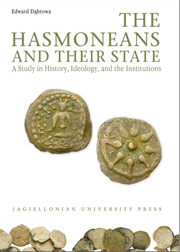Book contents
- Frontmatter
- Contents
- Introduction
- Abbreviations
- Part I Judea under the Hasmoneans (167–63 BCE)
- Part II The Institutions of the Hasmonean State
- Part III Society
- Conclusions
- Bibliography
- Index of Personal Names
- Index of Place Names
- Index of Ancient Sources
- Electrum - Volumes Published
- The Hasmonean State
Conclusions
Published online by Cambridge University Press: 05 September 2014
- Frontmatter
- Contents
- Introduction
- Abbreviations
- Part I Judea under the Hasmoneans (167–63 BCE)
- Part II The Institutions of the Hasmonean State
- Part III Society
- Conclusions
- Bibliography
- Index of Personal Names
- Index of Place Names
- Index of Ancient Sources
- Electrum - Volumes Published
- The Hasmonean State
Summary
It is not without a reason that the first part of the present study shows the history of the rise, flowering, and decline of the Hasmonean monarchy against a backdrop of events in neighboring states. Only in such context is it possible to assess properly the rule by that family and dynasty, and to discern their inspirations in creating institutions for their own statehood. Such a historical perspective is also necessary to trace the development of those institutions.
First attempts to create public institutions were made already by Judah Maccabee. He recognized the need to organize the insurrectionist movement in structures to permit more efficient leadership. Such institutions included those geared to providing sustenance to insurrectionists, and to ensuring them a chance to share in some decision-making or to make their opinions heard. Judah Maccabee's death put an end to what he had achieved in this respect. After several years, the task of creating Judea's political institutions was undertaken by Jonathan. His diplomatic skill and success in combat enabled him to be recognized as no longer an enemy but an ally to the Seleucids. This status allowed him to begin laying foundations for his own governance in Judea, a task in which he was greatly helped by winning a leadership position on being named the high priest of the Temple. His close relations with Syrian kings involved Jonathan and his brother Simon in the world of Hellenistic politics. His active role in it enabled him not only to secure a large extent of independence from the Seleucids, but also to study closely the various aspects of Hellenistic monarchies in action.
- Type
- Chapter
- Information
- The Hasmoneans and their StateA Study in History, Ideology, and the Institutions, pp. 187 - 190Publisher: Jagiellonian University PressPrint publication year: 2009



